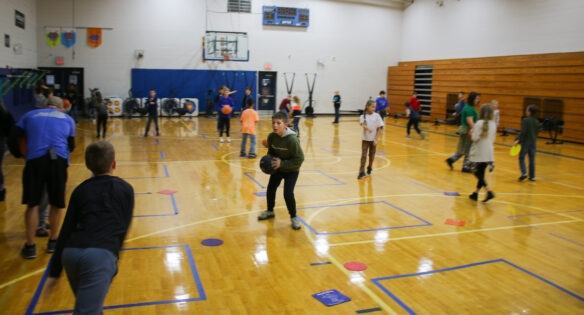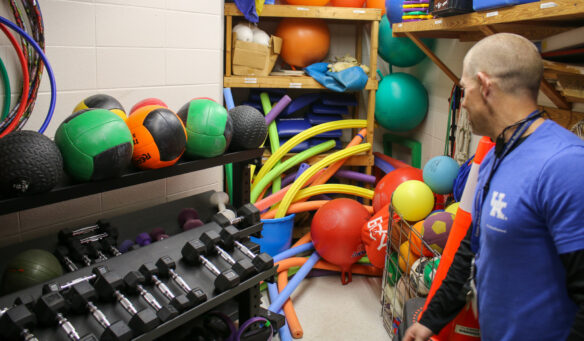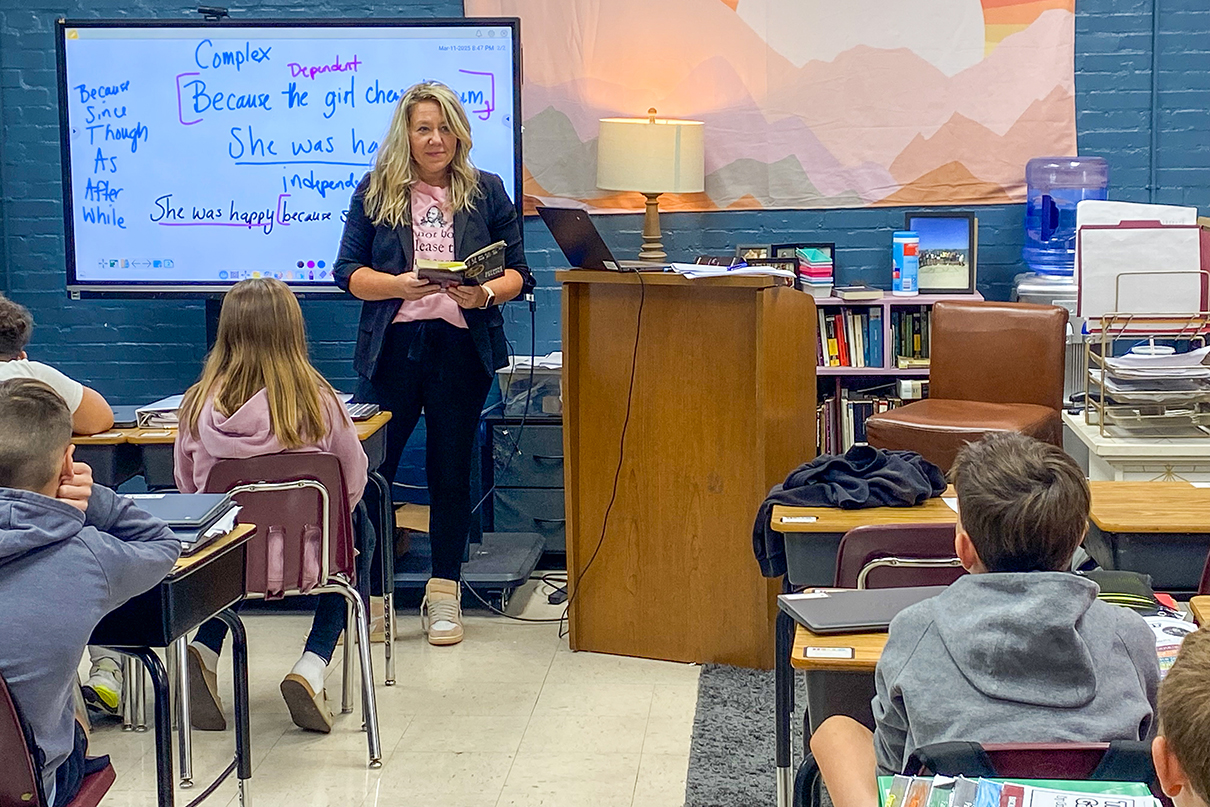
With help from the Kentucky Healthy Schools Team at the Kentucky Department of Education, health and physical education teacher Patrick Kennedy oversaw the transformation of Camp Dick Robinson (CDR) Elementary’s school culture to the promotion of a health-based culture. Photo by Caleb Bates. December 5, 2022
When Patrick Kennedy moved from Chicago to Lancaster in central Kentucky more than five years ago, he did not know the change he would initiate.
A veteran teacher, Kennedy accepted a health and physical education teaching position at rural Camp Dick Robinson (CDR) Elementary (Garrard County). He moved to the community to raise his family in a quieter environment.
Early during his tenure at CDR, Kennedy decided to take on a project that would forever alter the school: the promotion of a health-based culture. “I was a big go-getter. I wanted it to change within six months,” he said.
However, he knew that changing the school’s culture required cultivating a sense of community around health education. With help from the Kentucky Healthy Schools Team at the Kentucky Department of Education (KDE), Kennedy oversaw the transformation.
“(It) really showed me that I need to get parents involved who would support it. I need to educate the administration and get them on my side from there. Once I do that, I’ve got to educate the teachers,” he said of his mindset at the time.
Kennedy got them all involved – the parents, administrators and the teachers – and was able to show them his idea can work and can help students succeed. Kennedy began zero-hour fitness at CDR, a time in the mornings set aside for students who face challenges at home. The students complete what he called “fun fitness activities” on Monday, Wednesday and Friday, and workouts on Tuesday and Thursday.
Kennedy’s philosophy of holistic health and physical education is a major concept within health and physical education. The Kentucky Healthy Schools Team focuses on the Whole School, Whole Community, Whole Child (WSCC) initiative, a collaborative effort between the Kentucky Department of Education and the Kentucky Department for Public Health.
The Garrard County School District was awarded a WSCC grant, expanding opportunities for Kennedy and the students at CDR.
He said his experience has been successful thus far, and his mission of integrating health into the school is reaping positive results.
“We’ve been able to show data. We were able to show the data of ‘Hey, you know our scores are on the uprise? We’re outperforming other schools in our area.’ And we think the whole movement is a big part of it,” he said.
Staff members also bought into the concept.
“Increasing movement opportunities for our students and staff has made such a positive impact on the culture of our school. Our students not only participate in the movement activities, but are educated on the value that movement has on their bodies and brains,” Principal Lesley Lawson said. “Our students understand how critical physical activity is to a successful day and how it affects both academics and social emotional learning.”
Before the program, Kennedy said health and physical education time often was used for behavior interventions, counseling sessions and test makeups. That is no longer the case.
“We’re very lucky with our general education teachers. They fill out our attendance for me,” he said. “My students are hardly ever pulled. Kids don’t miss PE because of bad behavior or because they didn’t do their homework. Teachers see that this is going to help their kids.”

The Garrard County School District was awarded a Whole School, Whole Community, Whole Child (WSCC) grant to help promote a healthy school culture. Photo by Caleb Bates. December 5, 2022.
Kennedy said movement integration has resulted in positive changes beyond test scores.
“I have noticed an increased level in productivity,” said LeeAnn Blair, a deeper learning teacher leader at the school.
She said she recognizes that creative approaches are critical because movement in the gym is not always an option. According to her, allowing students to take one minute to breathe and reflect makes a big difference.
Kennedy said that “we really feel – as physical education teachers – we help not only in the regular classroom, but we help people for the rest of their lives. We realize that’s going to help students be successful citizens and successful people in society.”
He recognizes that granting students choice in their participation allows for deeper engagement. Students can choose between riding an exercise bike or completing a set of jumping jacks, for example.
“I’ve learned over the years that I have kids who are not going to run as fast as they can, they’re not going to give it as much. But if I can just get them walking and moving, it’s really going to benefit their day. It doesn’t have to be high intensity – it can be low intensity,” he said.
Kennedy focuses on mental health as well as physical, and he teaches his students skills they can use for group work and more.
“We do a lot of partner work and a lot of talking,” he said.
As an example, Kennedy shows one of his classes a picture, then divides the class into partners of two, and asks them to think about the meaning behind it. A game of rock, paper, scissors decides which partner shares first.
“That really goes into social-emotional learning: learning how to take turns, be a good listener and be prepared when it’s turn to speak,” he said. “That goes into self-management, self-awareness, responsible decision-making and relationship skills.”
“We always end class with a mindful minute. We dim the lights, we put on our lower music of lower intensity. The students are instructed to lay down and deep breathe, closing their eyes and getting their heart rate back down, flooding their brain with oxygen, getting prepared to go back to class,” he said.
The mindful minute prefaces math class.
“They do fitness and go right to math class because for a lot of kids, math class is a really big struggle. We try to get that spike of oxygen to the brain right before math in hopes that it can help them with their mindset.”
To learn more about the collaborative effort to promote health through schools, visit the WSCC initiative webpage.



I’m so proud of the effect Patrick has had on the school system and the children. It is his passion not doubt. I hope people listen and follow his wise effort to effect children and adults throughout his school system